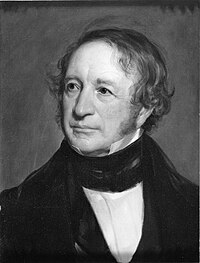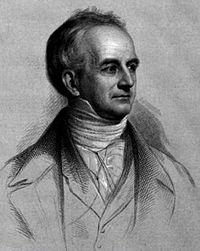The Boston Associates



The Boston Associates were a loosely linked group of investors in 19th-century New England. They included Nathan Appleton, Patrick Tracy Jackson, Abbott Lawrence, and Amos Lawrence. Often related directly or through marriage, they were based in Boston, Massachusetts. The term "Boston Associates" was coined by historian and professor of economics and Marxism, Vera Shlakman in her 1935 work, Economic History of a Factory Town, A Study of Chicopee, Massachusetts.[1]
Investments
By 1845, 31 textile companies—located in Massachusetts, New Hampshire, and southern Maine—produced one-fifth of all cotton and wool textiles in the United States. With the capital earned through these mills, they invested in railroads, especially the Boston and Lowell. These railroads helped transport the cotton from warehouses to factories. These Boston-based investors established banks—such as the Suffolk Bank—and invested in others. In time, they controlled 40% of banking capital in Boston, 40% of all insurance capital in Massachusetts, and 30% of Massachusetts' railroads. Tens of thousands of New Englanders received employment from these investors, working in any one of the hundreds of their mills.[2]
Mill locations established or improved by the Boston Associates:[3]
- Waltham, Massachusetts (1813)
- Lowell, Massachusetts (1822)
- Manchester, New Hampshire (1825)
- Saco, Maine (1831)
- Nashua, New Hampshire (1836)
- Dover, New Hampshire (1836)
- Chicopee, Massachusetts (1838)
- Lawrence, Massachusetts (1845)
- Holyoke, Massachusetts (1847)
Philosophy
Despite being "shrewd, far-sighted entrepreneurs who were quick to embrace...new investment opportunities", the Boston Associates were also "committed to the ideals of the original Protestant ethic and Republican simplicity". Indeed, the members established more than 30 "benevolent societies and institutions" between 1810 and 1840. Their investment in the Boston Manufacturing Company's Lowell Mills project, which Henry Clay called a test for "whether the manufacturing system is compatible with social virtues", epitomized their worldview.[4]
List of members
Though not authoritative or necessarily complete, Robert Dalzell's 1987 book, Enterprising elite: The Boston Associates and the world they made, enumerated the following businessmen as members of the Boston Associates social strata:[5][6]
- Nathan Appleton
- William Appleton
- Samuel Batchelder
- Kirk Boott
- John Bromfield Jr.
- Nathaniel Bowditch
- Samuel Cabot
- Edmund Dwight
- Patrick Tracy Jackson
- Abbott Lawrence
- Amos Lawrence
- James Lloyd
- John Amory Lowell
- Francis Cabot Lowell
- George W. Lyman
- Paul Moody
- Daniel Pinckney Parker
- Thomas Handasyd Perkins
- Ignatius Sargent
- David Sears
- Charles Storer Storrow
- Israel Thorndike
See also
Further reading
- Dalzell, Robert F. Enterprising elite: The Boston Associates and the world they made (Harvard University Press, 1987)
- Dalzell, Robert. "The Boston Associates and the Rise of the Waltham-Lowell System: A Study In Entrepreneurial Motivation." in Robert Weible, ed. The Continuing Revolution: A History of Lowell, Massachusetts (1991) pp: 39-75.
- Hartford, William F. Money, morals, and politics: Massachusetts in the age of the Boston Associates (Northeastern University Press, 2001)
- Malone, Patrick M. Waterpower in Lowell: Engineering and Industry in Nineteenth-Century America (2009)
- Sobel, Robert The Entrepreneurs: Explorations Within the American Business Tradition (Weybright & Talley 1974), chapter 1, Francis Cabot Lowell: The Patrician as Factory Master. ISBN 0-679-40064-8
- Prince, Carl E., Seth Taylor. "Daniel Webster, the Boston Associates, and the U.S. Government's Role in the Industrializing Process, 1815-1830" Journal of the Early Republic (Autumn, 1982) 2#3, pp. 283–299
- Weil, Francois. "Capitalism and Industrialization in New England, 1815-1845." Journal of American History Vol. 84, No. 4 (Mar., 1998), pp. 1334–1354.
- Farrow; Anne, John Lang; Jennifer Frank; "Complicity: How the North Promoted, Prolonged, and Profited from Slavery." Chapter 1. Ballantine Books, The Hartford Courant Company: Hartford, Connecticut. 2005.
References
- ^ Vera Shlakmen, Economic History of a Factory Town, A Study of Chicopee, Massachusetts, 1935
- ^ Heller, Michael (2009). Commons and anticommons. ISBN 978-1-78536-278-1. OCLC 1028747076.
- ^ The Run of the Mill, Steve Dunwell, 1978
- ^ Shi, David E. (1985). The Simple Life: Plain Living and High Thinking in American Culture. Athens, GA: University of Georgia Press. pp. 93–98. ISBN 978-0195034752. Retrieved 27 January 2018.
- ^ Carpenter, Kenneth (November 2020). "Why George Washington's Library is Not at Harvard". Harvard Library Bulletin. Harvard University.
- ^ Dalzell, Robert F. (1987). Enterprising elite: The Boston Associates and the world they made. Harvard University Press. pp. 233–238.
